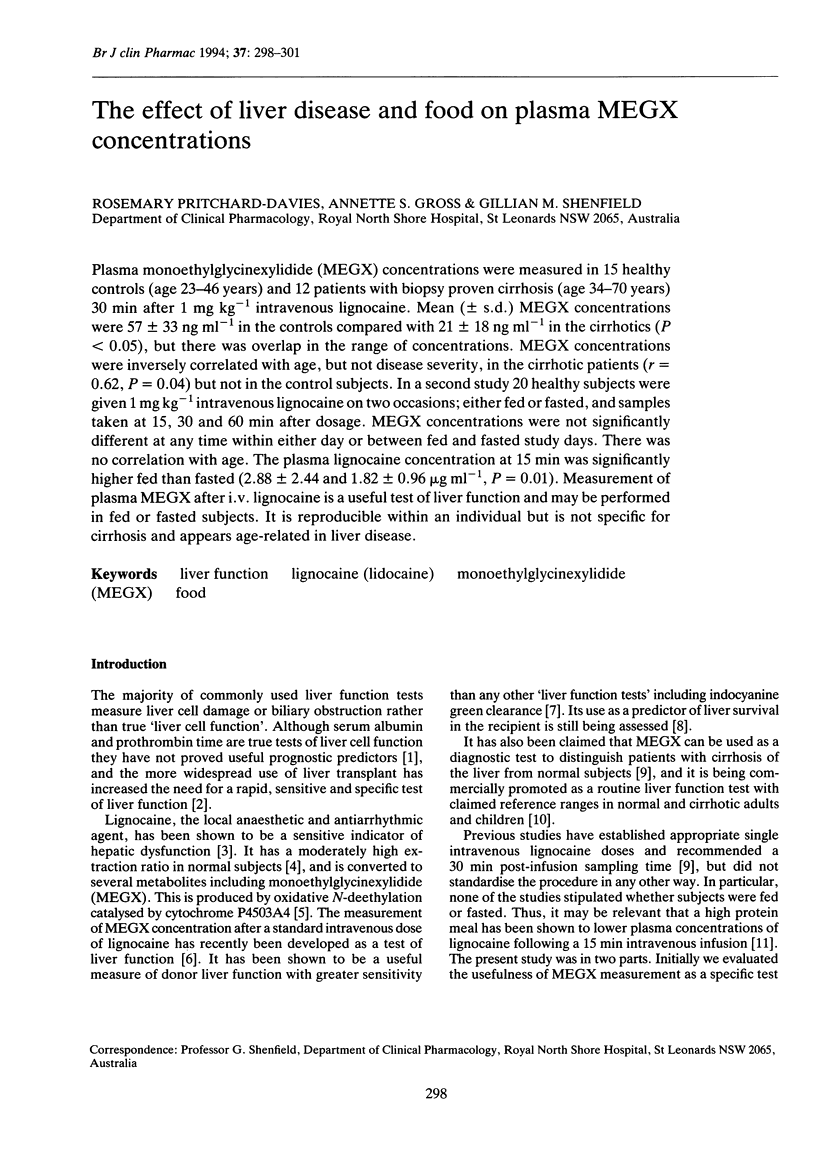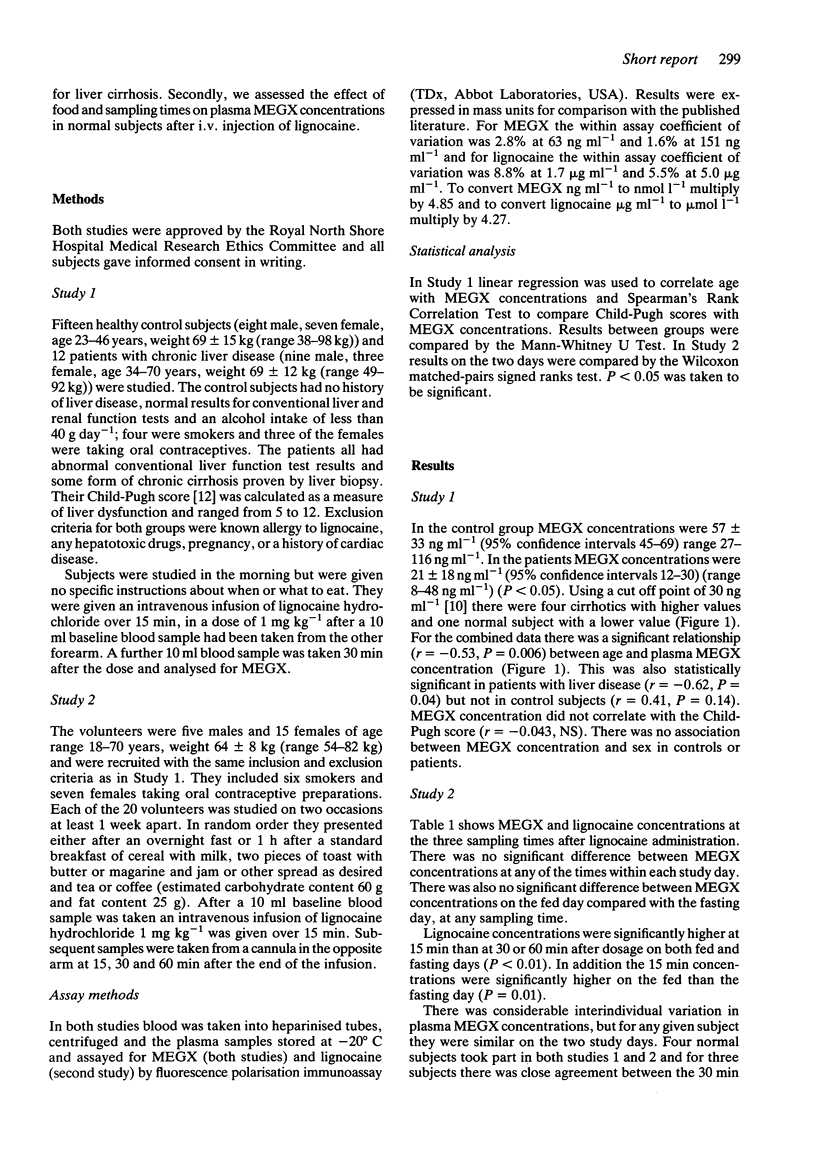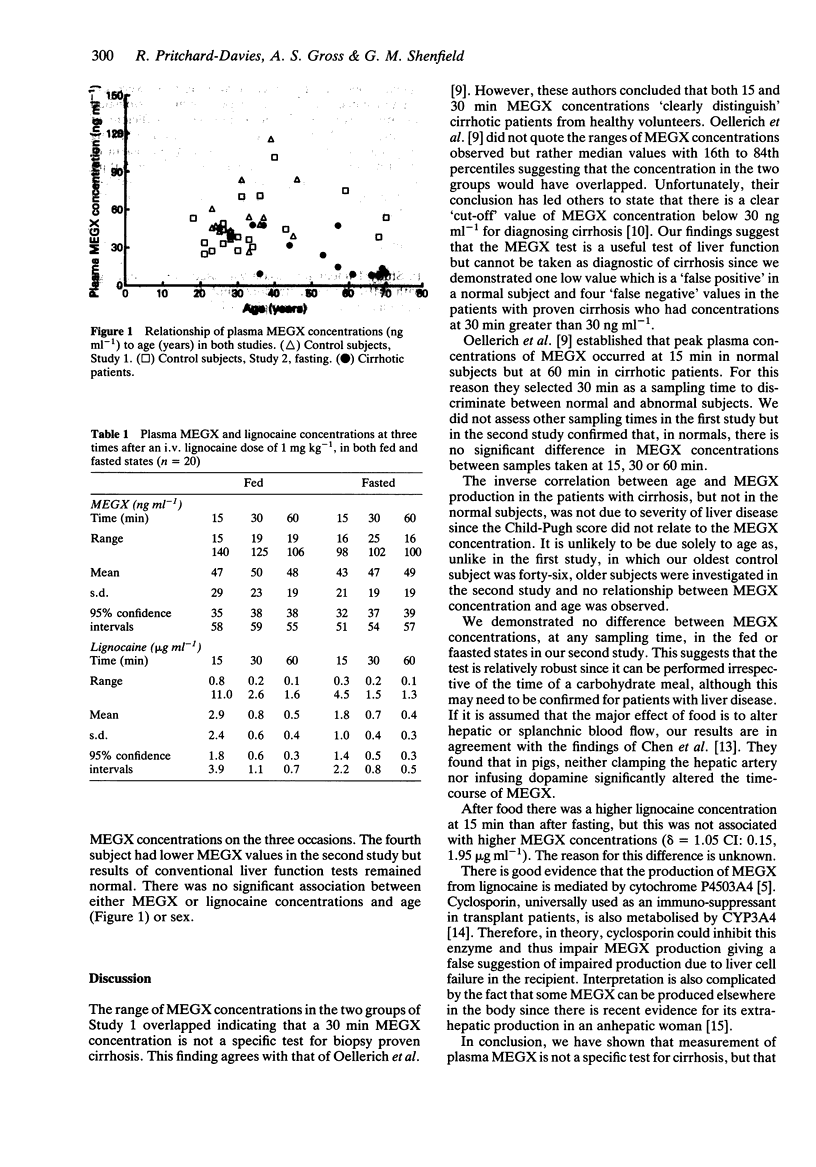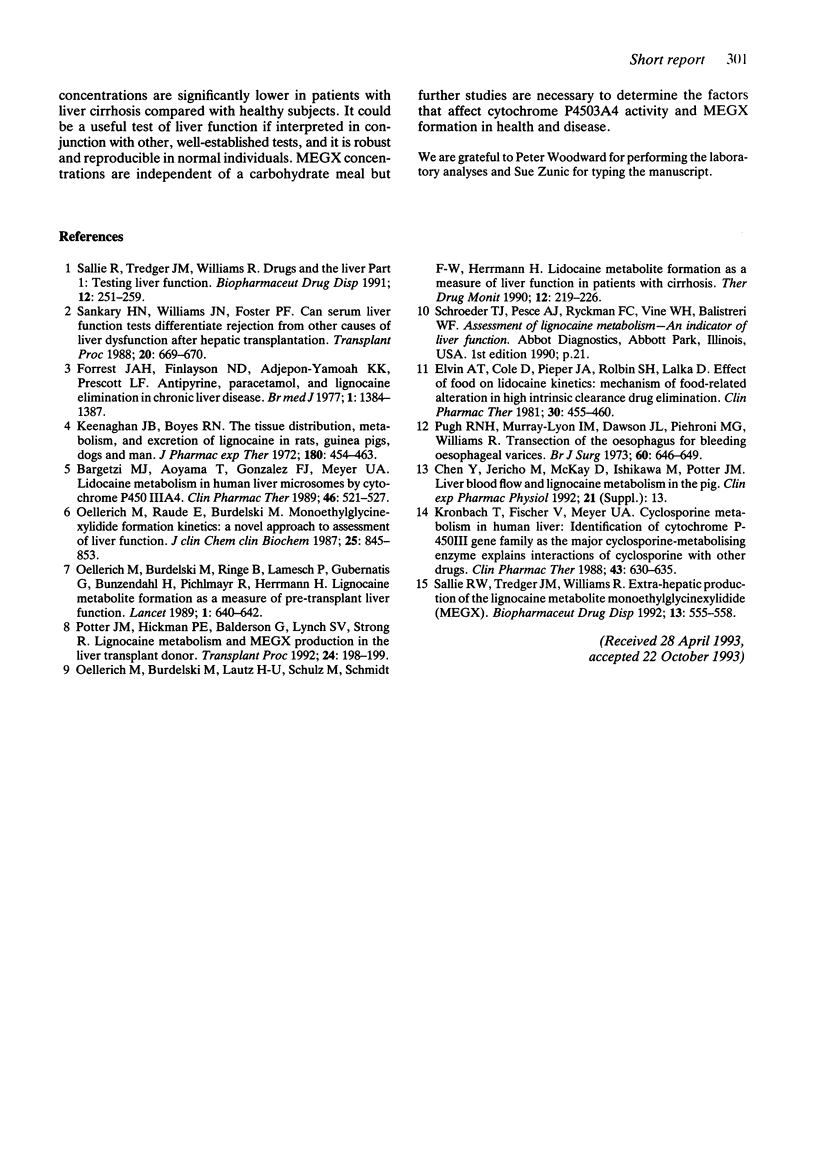Abstract
Plasma monoethylglycinexylidide (MEGX) concentrations were measured in 15 healthy controls (age 23-46 years) and 12 patients with biopsy proven cirrhosis (age 34-70 years) 30 min after 1 mg kg-1 intravenous lignocaine. Mean (+/- s.d.) MEGX concentrations were 57 +/- 33 ng ml-1 in the controls compared with 21 +/- 18 ng ml-1 in the cirrhotics (P < 0.05), but there was overlap in the range of concentrations. MEGX concentrations were inversely correlated with age, but not disease severity, in the cirrhotic patients (r = 0.62, P = 0.04) but not in the control subjects. In a second study 20 healthy subjects were given 1 mg kg-1 intravenous lignocaine on two occasions; either fed or fasted, and samples taken at 15, 30 and 60 min after dosage. MEGX concentrations were not significantly different at any time within either day or between fed and fasted study days. There was no correlation with age. The plasma lignocaine concentration at 15 min was significantly higher fed than fasted (2.88 +/- 2.44 and 1.82 +/- 0.96 micrograms ml-1, P = 0.01). Measurement of plasma MEGX after i.v. lignocaine is a useful test of liver function and may be performed in fed or fasted subjects. It is reproducible within an individual but is not specific for cirrhosis and appears age-related in liver disease.
Full text
PDF



Selected References
These references are in PubMed. This may not be the complete list of references from this article.
- Bargetzi M. J., Aoyama T., Gonzalez F. J., Meyer U. A. Lidocaine metabolism in human liver microsomes by cytochrome P450IIIA4. Clin Pharmacol Ther. 1989 Nov;46(5):521–527. doi: 10.1038/clpt.1989.180. [DOI] [PubMed] [Google Scholar]
- Elvin A. T., Cole A. F., Pieper J. A., Rolbin S. H., Lalka D. Effect of food on lidocaine kinetics: mechanism of food-related alteration in high intrinsic clearance drug elimination. Clin Pharmacol Ther. 1981 Oct;30(4):455–460. doi: 10.1038/clpt.1981.188. [DOI] [PubMed] [Google Scholar]
- Forrest J. A., Finlayson N. D., Adjepon-Yamoah K. K., Prescott L. F. Antipyrine, paracetamol, and lignocaine elimination in chronic liver disease. Br Med J. 1977 May 28;1(6073):1384–1387. doi: 10.1136/bmj.1.6073.1384. [DOI] [PMC free article] [PubMed] [Google Scholar]
- Keenaghan J. B., Boyes R. N. The tissue distribution, metabolism and excretion of lidocaine in rats, guinea pigs, dogs and man. J Pharmacol Exp Ther. 1972 Feb;180(2):454–463. [PubMed] [Google Scholar]
- Kronbach T., Fischer V., Meyer U. A. Cyclosporine metabolism in human liver: identification of a cytochrome P-450III gene family as the major cyclosporine-metabolizing enzyme explains interactions of cyclosporine with other drugs. Clin Pharmacol Ther. 1988 Jun;43(6):630–635. doi: 10.1038/clpt.1988.87. [DOI] [PubMed] [Google Scholar]
- Oellerich M., Burdelski M., Lautz H. U., Schulz M., Schmidt F. W., Herrmann H. Lidocaine metabolite formation as a measure of liver function in patients with cirrhosis. Ther Drug Monit. 1990 May;12(3):219–226. doi: 10.1097/00007691-199005000-00002. [DOI] [PubMed] [Google Scholar]
- Oellerich M., Burdelski M., Ringe B., Lamesch P., Gubernatis G., Bunzendahl H., Pichlmayr R., Herrmann H. Lignocaine metabolite formation as a measure of pre-transplant liver function. Lancet. 1989 Mar 25;1(8639):640–642. doi: 10.1016/s0140-6736(89)92144-2. [DOI] [PubMed] [Google Scholar]
- Oellerich M., Raude E., Burdelski M., Schulz M., Schmidt F. W., Ringe B., Lamesch P., Pichlmayr R., Raith H., Scheruhn M. Monoethylglycinexylidide formation kinetics: a novel approach to assessment of liver function. J Clin Chem Clin Biochem. 1987 Dec;25(12):845–853. doi: 10.1515/cclm.1987.25.12.845. [DOI] [PubMed] [Google Scholar]
- Potter J. M., Hickman P. E., Balderson G., Lynch S. V., Strong R. Lignocaine metabolism and MEGX production in the liver transplant donor. Transplant Proc. 1992 Feb;24(1):198–199. [PubMed] [Google Scholar]
- Pugh R. N., Murray-Lyon I. M., Dawson J. L., Pietroni M. C., Williams R. Transection of the oesophagus for bleeding oesophageal varices. Br J Surg. 1973 Aug;60(8):646–649. doi: 10.1002/bjs.1800600817. [DOI] [PubMed] [Google Scholar]
- Sallie R. W., Tredger J. M., Williams R. Extrahepatic production of the lignocaine metabolite monoethylglycinexylidide (MEGX). Biopharm Drug Dispos. 1992 Oct;13(7):555–558. doi: 10.1002/bdd.2510130709. [DOI] [PubMed] [Google Scholar]
- Sallie R., Tredger J. M., Williams R. Drugs and the liver. Part 1: Testing liver function. Biopharm Drug Dispos. 1991 May;12(4):251–259. doi: 10.1002/bdd.2510120403. [DOI] [PubMed] [Google Scholar]
- Sankary H. N., Williams J. W., Foster P. F. Can serum liver function tests differentiate rejection from other causes of liver dysfunction after hepatic transplantation? Transplant Proc. 1988 Feb;20(1 Suppl 1):669–670. [PubMed] [Google Scholar]


